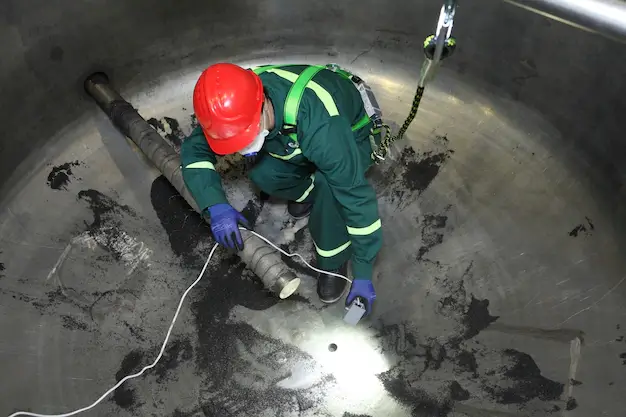Back injuries are very common in workplaces. And workplaces like oil and gas sites have the dark side which means they can explore anytime and anywhere. Many people work in these industries as it involves workers lifting, carrying, pulling, or pushing heavy objects. These actions can lead to back injuries and joint fractures by lifting or carrying in the wrong way or wrong position.
Oil and gas industries have their own security and protective guidelines to avoid any kind of explosions, injuries, and losses. But after all, these are just mechanisms that can go wrong at any time and for any reason, after taking all precautions and protections.

WHAT ARE THE 30 BASIC PRECAUTIONS TO TAKE IN GAS OR OIL INDUSTRIES?
- All the accidents, fires or spills, and material damages like potentially serious incidents should be reported to the control room, The supervisor, or the safety officer.
- Handrails and walkways must be used.
- Vehicles shall be parked without blocking roads or fire-fighting equipment.
- The general speed limit of 10 km/h must be observed throughout the terminal.
- Drivers of all vehicles should obey traffic signs and regulations and always use their seatbelts while driving.
- Garbage and waste must be collected and disposed of in dedicated containers.
- Eating and drinking are not permitted outside the office building and other dedicated rooms.
- It is forbidden to consume alcohol, drugs, or other intoxicants on the site or to be under the influence when at work.
- The minimum personal protective equipment consisting of safety helmets, Anti-static safety shoes with product-resistant souls and antistatic long-sleeved protective clothing shall be worn at all times.
- Carrying private mobile phones is prohibited within the licensed area.
- Smoking is prohibited throughout the terminal.
- Carrying sources of ignition like lighters or matches is prohibited.
- Using radios, cameras, calculators, or battery-powered hearing devices is only allowed with special permission from the management.
Specialty Care Clinics have the best doctors who can fix spinal cord-related injuries please visit https://specialtycareclinics.com/ and call (469) 545- 9983 to book an appointment.

- No excavation work in the area without clearance of explosive ordnance disposal.
- No mechanical excavation closer than 5m to any hydrocarbon-carrying pipeline.
- No mechanical excavation closer than 3m to non-hydrocarbon carrying pipelines, cables, and services.
- For any excavation deeper than 1m, the ladder must be positioned at a projecting minimum of 1 m above the edge of the excavations.
- Ladders shall be provided every 7.5 m means 25 feet of lateral travel in the trench.
- Leaders shall be securely supported at the bottom as well as at the top.
- Excavated material shall be placed 1 m from the edge of the excavation for a depth of up to 1.2 m.
- Heavy equipment and machinery shall be kept at least 3 meters away from the edge.
- Any walkway in a Cross trench shall have a scaled-type platform with handrails.
- All trenches shall have barriers such as fixed guard rails and reflective warning notices clearly displayed.
- Call each other to Account for wearing PPE and regularly check the condition of PPE.
- No mechanical excavation is allowed inside the existing KOC facilities such as the gathering Centre, booster station, water injection, and healing facilities, etc.
- Proper training to lift heavy objects such as carts, pallet jacks, dollies, pneumatic lifts, and forklifts for workers is mandatory.
- Flashing lights are mandatory during poor visibility.
- Workers should determine the shortest, obstacle-free path to reach the load to its final destination.
- Regular exercise and stretching can help the workers to work out to carry the loads.
- Talking or being busy in an unnecessary manner with co-workers while working is prohibited.
Also keeping controlling engineering, administrative, and personal protective equipment and objectives can help avoid any kind of injuries. Proper training and good communication among the employees are the keys to keeping all workers safe.
Workers should follow all these safety precautions to stay safe and healthy.
Oil and gas site jobs are the most high-energy required jobs which include lifting or carrying heavy objects etc. Poor posture, incorrect lifting, improper body mechanics, or poor physical condition can cause severe back injury. And force is the most common cause of back injuries for workers in oil and gas sites. And also falls, slips or trips by heights, explosions, fire burns, repetitive stress, being struck in moving machinery or carts, or accidents related to vehicles on the site can lead to severe back injuries.
After taking all the precautions to not to be injured, still a person can meet an accident or things can go wrong. So a worker can get back to his work after the recovery. Every person‘s ability to heal is different and assuming how soon a patient can resume their work, depends on the type and the severity of injury. So safety should be the number one priority for the workers.
Working all day with back pain is really painful, please visit https://specialtycareclinics.com/ and call (469) 545-9983 to book an appointment.
